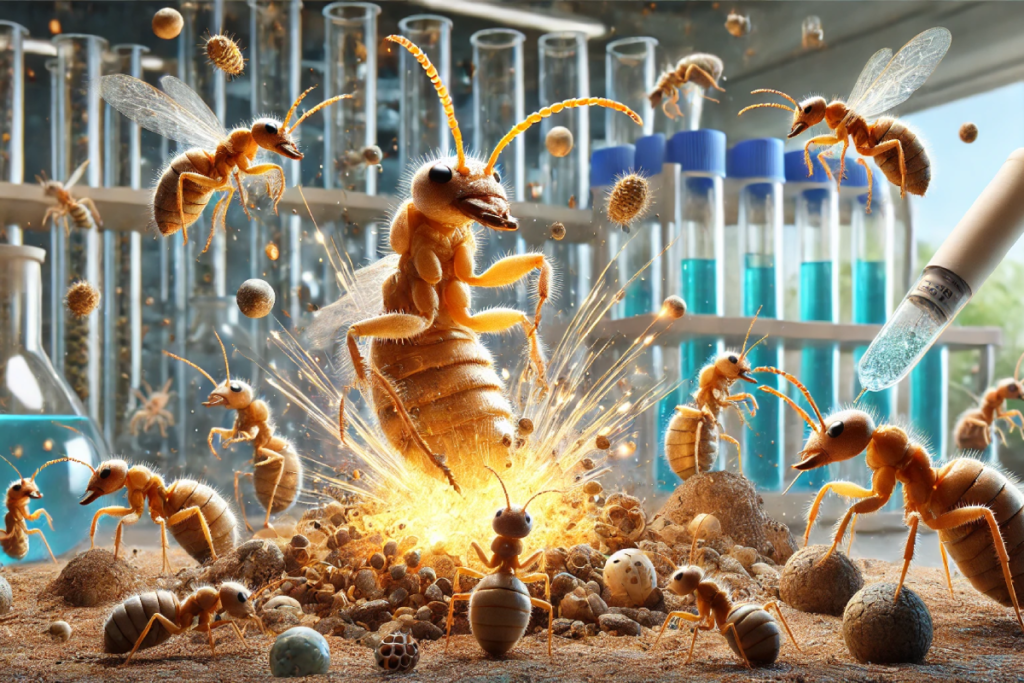In a fascinating display of nature’s complexity, scientists have recently discovered how certain termites engage in self-destructive behavior to protect their colonies. These so-called “kamikaze termites” possess a unique biological mechanism that allows them to detonate themselves, releasing toxic chemicals in the process to ward off predators. This discovery sheds light on the extreme strategies employed by some insect species to ensure the survival of their colonies. In this blog post, we will delve into how these termites detonate themselves, the significance of the discovery, and the broader implications for understanding insect behavior and defense mechanisms.
How Kamikaze Termites Detonate Themselves
The ability of kamikaze termites to detonate is the result of a highly specialized biological process that has evolved as a defense mechanism. High-volume keywords: “kamikaze termites,” “termite self-detonation,” “termite defense mechanisms.”
Biological Mechanism of Detonation
Researchers have found that older worker termites in certain species, such as Neocapritermes taracua, possess specialized glands filled with toxic blue crystals. These glands are located near the termite’s abdomen. When a threat approaches, such as an invading insect, the termite contracts its body, causing the glands to rupture. This rupture releases a lethal chemical mixture that not only kills the termite but also harms or deters the intruder.
Example: The termites’ detonation process is likened to that of a “suicide bomber,” sacrificing themselves for the greater good of the colony by releasing toxins that incapacitate their enemies.
Chemical Composition of the Explosion
The chemicals released during this self-detonation process are a potent mix of toxins. The blue crystals, produced over the termite’s lifetime, interact with salivary gland secretions, creating a chemical reaction that produces a toxic spray. This spray is lethal to smaller invaders and serves as an effective line of defense.
Example: In laboratory studies, researchers observed how the toxic discharge successfully killed attacking ants, protecting the termite colony from invasion.
The Evolutionary Significance of Kamikaze Termites
The behavior of kamikaze termites raises intriguing questions about the evolutionary advantages of self-sacrifice in insect societies. High-volume keywords: “evolution of termite defense,” “insect self-sacrifice,” “social insect behavior.”
Altruistic Behavior in Termites
Kamikaze termites represent an extreme example of altruistic behavior in social insects. In most termite colonies, the survival of the colony is prioritized over individual survival. These termites, particularly the older workers nearing the end of their life cycle, are willing to sacrifice themselves for the colony’s benefit. This behavior is consistent with evolutionary theories that explain how social insects often exhibit altruism, as the survival of the colony ensures the continuation of their genes.
Example: Similar altruistic behaviors can be seen in other social insects like bees, where worker bees will sting intruders and sacrifice themselves in the process.
Adaptive Defense Strategy
The discovery of kamikaze termites also highlights the diversity of defense mechanisms evolved by insects. Unlike other species that rely on strength or speed to defend themselves, termites have evolved an internal biological weapon capable of inflicting significant damage to predators. This unique strategy has allowed termite colonies to thrive in environments where they are constantly under threat from predators like ants, spiders, and even larger animals.
Example: The termite’s ability to develop such a complex defense mechanism demonstrates the intricate evolutionary adaptations that occur in the animal kingdom to ensure survival.
Implications of the Discovery
The discovery of kamikaze termites has broad implications for the study of insect behavior, evolution, and defense mechanisms. High-volume keywords: “insect defense research,” “kamikaze termite discovery,” “evolutionary biology insects.”
Insights into Social Insect Behavior
This finding adds to our understanding of social insect behavior, particularly how colonies protect themselves from external threats. By studying kamikaze termites, scientists can gain valuable insights into the evolution of social structures, cooperation, and division of labor in insect colonies.
Example: The research could also help scientists better understand how similar behaviors might evolve in other insect species and what environmental pressures drive such developments.
Potential Applications in Pest Control
While the discovery is primarily of academic interest, it may also have practical applications in pest control. Understanding the chemical mechanisms behind termite self-detonation could lead to new methods of controlling termite infestations, using natural or synthetic compounds to exploit the termite’s own defense mechanisms against them.
Example: Researchers might investigate whether it is possible to trigger similar chemical reactions in termite colonies that threaten human structures, providing a targeted pest control solution.
Conclusion
The discovery of how kamikaze termites detonate themselves to protect their colonies is a remarkable example of nature’s ingenuity. This extreme form of altruism highlights the lengths to which social insects will go to ensure the survival of their colony. As research into these fascinating creatures continues, we may uncover even more surprising insights into the world of insect behavior and evolution.


